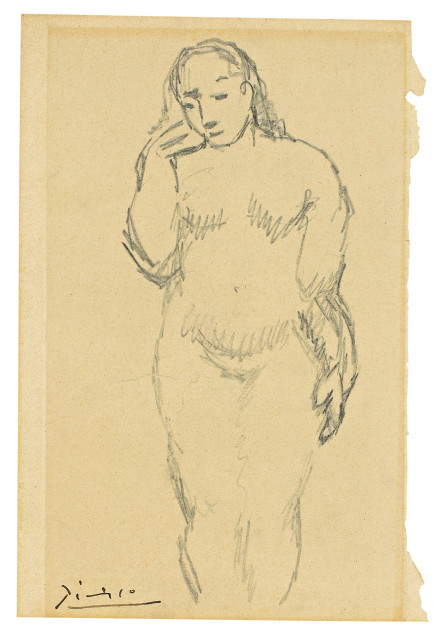- FR
S’inscrire
- Acheter
- Vendre
- Plus
- Galerie
- Commerce d'art
- Maison d'Édition
- Kornfeld aujourd’hui
- L'histoire de la Maison
- Informations





Málaga 1881 - 1973 Mougins
1905
Pencil drawing
17,1x11,7 cm
Signed "Picasso" by the artist in pen and ink at lower left. On the reverse of the sheet with the remark that the signature was subsequently applied by the artist in January 1956
Certificate of authenticity from Claude Picasso on photo, dated 4.4.2011, copy available. With a confirmation from "Picasso Authentification" dated 26.11.2013 that the work is recorded in the archives
Acquired around 1956 from the previous owner
Christie's Auction, New York, 5.5.2011, cat. no. 135
Private collection Europe
On beige wove paper (papier vélin) with irregular right margin. Mounted on cardboard, minimally browned, with light margins. In the centre old restored tears in the paper
From 1904 to 1909 Picasso worked in Paris in the legendary "Bateau-Lavoir" on Montmarte. After his "Blue Period", in which melancholy and sadness predominated, the turning point came in 1905: The "Pink Period" celebrated life. Jugglers, artists and the exuberant life found their way into the master's oeuvre. He also worked increasingly on nudes, in which the bodies became more voluminous. The faces seem to be transformed into masks, a type of representation that would lead to Picasso's groundbreaking work "Les Demoiselles d'Avignon"
1905
Bleistiftzeichnung
17,1x11,7 cm
Unten links vom Künstler in Feder in Tusche signiert "Picasso". Rückseitig auf dem Blatt mit der Bemerkung, die Signatur sei nachträglich im Januar 1956 vom Künstler angebracht worden
Echtheitszertifikat von Claude Picasso auf Foto, datiert vom 4.4.2011, liegt in Kopie vor. Mit einer Bestätigung der "Picasso Authentification" vom 26.11.2013, dass das Werk in den Archiven erfasst ist
Erworben um 1956 vom Vorbesitzer
Auktion Christie's, New York, 5.5.2011,
Privatsammlung Europa
Auf beigem Velin mit unregelmässigem, rechten Rand. Aufgezogen auf Karton, minim gebräunt, mit Lichtrand. In der Mitte alt restaurierte Risse im Papier
Von 1904 bis 1909 arbeitete Picasso in Paris im legendären "Bateau-Lavoir" auf dem Montmarte. Nach seiner "Blauen Periode", in welcher Melancholie und Traurigkeit vorherrschten, kam 1905 die Wende: Die "Rosa Periode" feierte das Leben. Gaukler, Artisten und das rauschende Leben fanden Einzug in das Œuvre des Meisters. Er arbeitete vermehrt auch an Aktdarstellungen, bei denen die Körper voluminöser werden. Die Gesichter scheinen dabei maskenhaft umgesetzt, eine Art Darstellung, die in der Weiterführung in Picassos bahnbrechendes Werk "Les Demoiselles d’Avignon" münden wird






